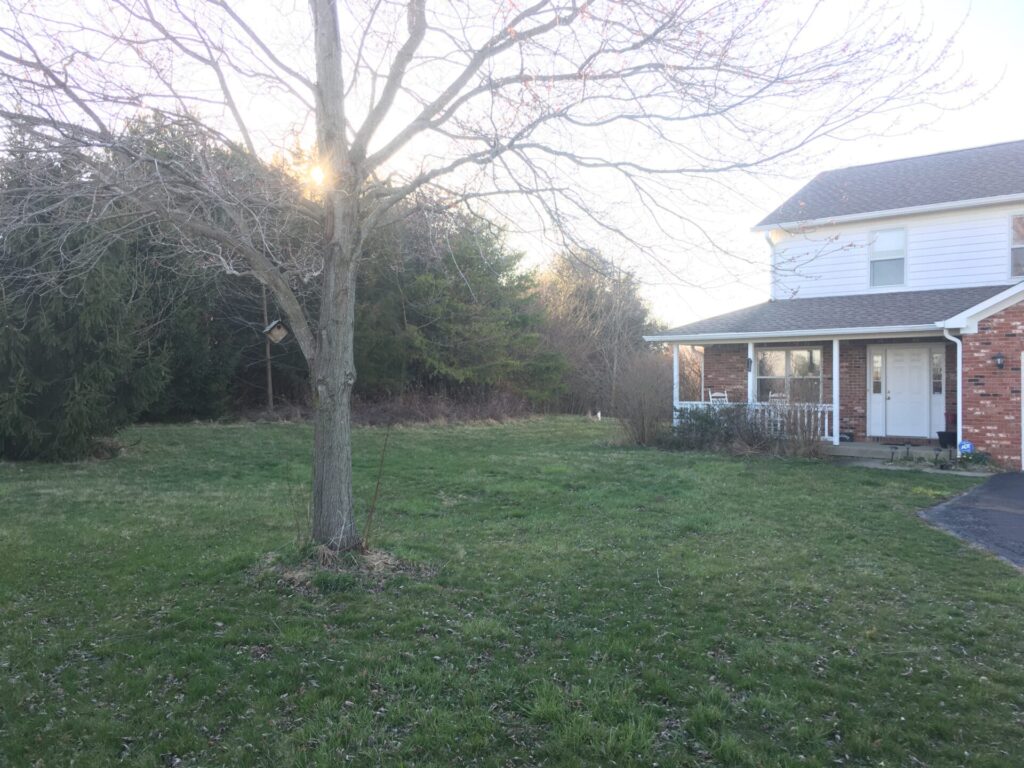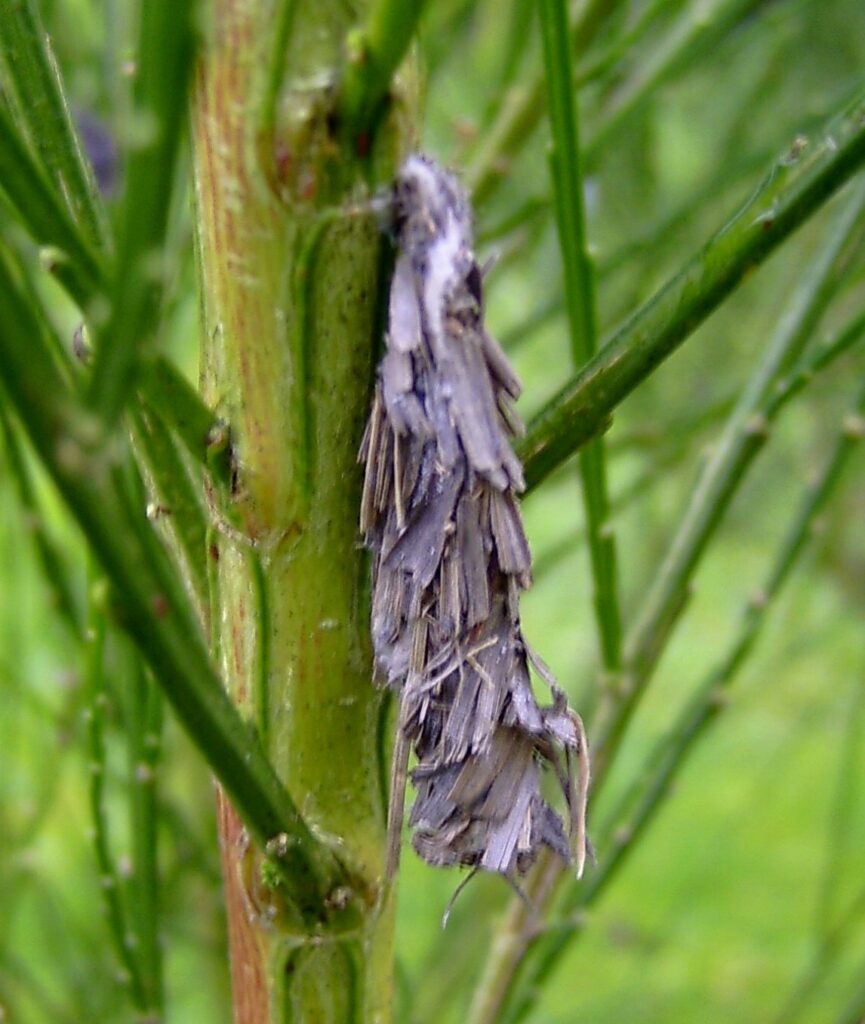By planting trees to create a windbreak around your house, you can lower your heating bills. If you own farmland, windbreaks can reduce soil erosion, saving precious topsoil. This page reviews some potential windbreak trees like Norway spruce, white pine and eastern red cedar.
Windbreaks can provide additional benefits besides reduced energy costs. They can function like a privacy fence and reduce noise. Birds and small mammals find they make excellent habitat. During the winter when everything else is dull and dormant, it is nice to see the green provided by conifers.
Planning Your Windbreak

The first consideration in planning your windbreak is the direction of the wind. The prevailing wind for most of Indiana comes out of the southwest, so you’ll want to place your windbreak to the southwest of your home. You don’t have to place the trees close to the house. The Department of Energy recommends planting your windbreak two to five times the mature height of the trees away from the building. However, space considerations will likely dictate that they will need to be planted closer.
Ideally, a windbreak should consist of at least five rows of trees, but even a single or double row will provide some reduction in wind velocity. Again, available space will likely dictate the number of rows. Plant conifers about eight feet apart within a row, and rows should be twelve feet apart. Stagger the rows so that wind passing between trees within a row will encounter a tree in the next row. Don’t plant evergreens too close to each other. This may cause them to drop their lower limbs as they mature, degrading their effectiveness at blocking wind.
Selecting Trees for Your Windbreak
Some sources recommend using some deciduous trees and shrubs in a windbreak, but according Iowa State University, they are only five to twenty percent as effective as conifers. There’s nothing wrong with some deciduous trees on the outside of the windbreak, but we recommend using only evergreens for the core. Most likely you want your windbreak to shelter you from cold winter winds, Deciduous trees won’t help much during that time of year.
I recommend using several tree species when creating a windbreak. This will give it a natural and aesthetically appealing look. There are several factors to consider when choosing conifers for a windbreak:
- Speed of growth – Obviously, you would like to have a functioning windbreak sooner than later.
- Density – Trees with dense branches and long needles are better at block wind.
- Soil requirements – If your location has poor soil, or if it is excessively dry to wet, you will need a tree that survive these conditions.
- Salt tolerance – If you are planting close to a road, your trees may be affected by road salt. Keep in mind that snow plows can throw snow and salt a considerable distance. Some conifers are much more tolerant of salt than others.
- Deer resistance – In some areas, browsing deer may damage or kill young trees. Deer tend to avoid certain evergreen species.
- Disease resistance – Some conifers are more susceptible than others to disease.
Suitable Species for Windbreak Trees
Here are some good evergreen choices for your windbreak:
- Norway spruce is an excellent choice for a windbreak tree. It is a fast grower and quite attractive, which also makes it an excellent landscape tree. Its branches are strong and tough, so it can withstand the weight of snow after a blizzard. Norway spruce develop an extensive root network, which helps them withstand wind.
- White spruce is another fast grower. With its dense foliage, it blocks the wind well. Its needles are somewhat bluish, but not as blue as Colorado blue spruce.
- Eastern red cedar has prickly foliage, making it deer resistant. It also grows in almost any soil conditions, so it’s a good choice for areas with poor soil. It is best to place them in the outside rows of your windbreak, since they do not tolerate shade well. The cedar waxwing got its name because of its fondness for this tree’s seed cones. Do not plant eastern red cedar near Washington hawthorn. They may be damaged by a fungus that requires both of these plants as hosts during its life cycle.
- Northern white cedar tolerates shade well, so it is a good choice for interior rows. There is a cultivar known as Mission arborvitae or techy arborvitae that some people prefer over the generic northern white cedar.
- White pine is one of America’s most popular conifers. It is a hardy tree that grows fast. It does well in most soil types. It can be easily identified – White pine is the only pine with five needles in a bunch.
- Red pine is a fast grower with long needles. It is disease resistant and grows well in dry soil. It tends to lose its lower branches as it matures. This shouldn’t be a problem if you have several rows in your windbreak, but it’s probably not a good choice if you have only one or two rows. Red pine and jack pine have two needles in a bunch. Most other pines have single needles.
- Austrian pine has excellent salt and smog tolerance, which makes it great for planting along roads and highways. It can also grow in poor soil and tolerates dry conditions well.
- Black Hills spruce resists disease and drought well. It is very cold hardy and can be grown in the coldest places in the continental United States. Its needle are short and a little prickly, which gives it some resistance to deer.
- Black spruce is a slow grower, so don’t expect it to block much wind in its first decade. However, it tolerates shade and wet soils very well. It’s probably the best choice for spots with wet soil that have too much shade for eastern red cedar.
- Canaan fir is very similar to balsam fir. Unlike the balsam fir, it can tolerate the warmer temperatures of central Indiana. It has dense foliage, and its flat needles are about an inch long. If you want a fir, this is the one for Indiana. Other firs like Douglas and concolor are adapted to the drier conditions out west and do not do well in our state.
- Canadian hemlock (Also called eastern hemlock) is hard to find and a little more expensive than other conifers. It is very tolerant of shade, so it is a good choice for interior portions of the windbreak. If you lose a tree after planting your windbreak and need to replace it, Canadian hemlock can thrive in the shade of the larger trees around it.
- Colorado blue spruce is prized for its unique blue color. It is easy to grow and tolerates drought well.
- Jack pine is somewhat scruffy looking and certainly not the most attractive pine tree. However, if you need something that will grow in poor, sandy soil, this is your answer.
- Virginia pine is another good choice for poor soil. It is often used to reclaim areas where coal was strip-mined. Its needles are shorter than most other pine trees.
One conifer that is not recommended as a windbreak tree in Indiana is the Scotch pine. Although they are fast growing with long needles, they are susceptible to pine wilt and often die at about ten years of age.
Preventing Damage from Deer
Deer can easily damage young trees by eating them or rubbing their antlers against them. Due to a lack of predators, their numbers have rebounded to the point that they are more numerous than they were before Europeans arrived in North America. Unseen in Indiana since 1893, deer were reintroduced into Indiana, beginning in 1934. By 1942, nearly three hundred had been released. Today’s deer population in Indiana is now estimated at well over half a million animals.
If you decide to put a fence around your property to keep deer out, it will need to be at least eight feet high. You can also put cages or guards around your trees. The easiest way to protect young trees is to use a product called Liquid Fence. You simply spray it on and around your trees and the smell keeps deer and rabbits away. Just remember to apply it once a month when your vegetation is dry.
Maintaining Your Windbreak
While your trees are small, you will need to keep weeds and grass down around them. Putting mulch around them will help to keep the ground around them from drying out, and also discourage weed growth. You’ll still need to hand pull or spray weed killer to take care of vegetation that grows through the mulch.
After a few years, your trees will be big enough that weeds and grass will not threaten them. You will need to remove any deciduous trees that sprout inside your windbreak. These may shade out your conifers if they are left to grow. Mulberry and maple trees often come up in plantings. If there are squirrels around, they are likely to bury walnuts and forget about them, which will lead to a walnut tree sprouting in your windbreak. Your conifers will probably not need any pruning, unless there are dead or broken branches.
You will need to plant additional trees if some of your original ones die, or if they loose their lower branches and put a whole in the windbreak. Generally, this won’t happen unless you plant them too close together. When planting tiny saplings with the proper spacing, it appears they are miles apart. Don’t worry – In a few years they will grow together and block the wind.
Watch Out for Bagworms

Insects should not be a problem for most conifers in Indiana, with one exception. There is a small moth that lays its eggs on an occasional deciduous tree, but mostly on evergreens. It especially prevalent on eastern red and northern white cedars. They are called bagworms because their caterpillars live in bags made from the host plant foliage. They usually do not cause serious damage unless there are large numbers of them, but they do consume foliage and are unsightly. The easiest way to deal with small infestations is to remove them by hand. For larger infestations you will need to use a pesticide.
For more information about bagworms, check out this document from the United States Forest Service.
Fighting the Dust Bowl with Windbreaks
During the 1930s, prairie states suffered severe drought. Combined with poor farming practices and high winds on the open prairie, this led to immense dust storms which wrecked the health and livelihoods of millions. During the worst of these, visibility was only three feet. To mitigate this disaster, the government began to educate farmers on practices to reduce soil erosion. The Civilian Conservation Corps planted over two hundred million trees to establish windbreaks that were collectively called the Great Plains Shelterbelt.
